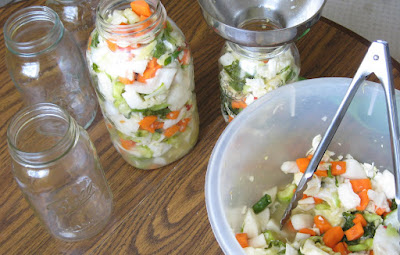
It's still winter--even in Knoxville, there is a steady chill, despite the few warm days last week. But it's the last stretch of winter, and in all my internal impatience for spring, I like to perform the actions of patience--the very patience that I will need to use in bringing little plants to life from seed. Making flavored liqueurs takes a kind of patience, as it takes time for the liqueur to mellow; and there's just something nice about making the liqueur
now, but not drinking it until June (when it will be warm, and we can drink margaritas in the moderate heat of early summer). (Making liqueurs, however, is a lot less labor-intensive than I had ever anticipated, so maybe not at all like growing little seedlings...)
After beginning the process for limoncello (and a small batch of lime-oncello), I kept coming back to the idea of an orange liqueur--something like triple sec, but less sweet, and with a stronger orange flavor. I also wanted it to be less potent than the limoncello, which will be about 40% alcohol when it's finished. And after looking up a few recipes for home-made triple sec, I was ready to try it. I do want to say that I changed the proportions of the recipes that I looked at, as they had in mind something all too sweet and syrupy. I imagine my orange liqueur retaining some of the bitterness of citrus, and some of the complexity. Here is what I used:
- One liter bottle of Tvarscki 100 proof vodka
- Seven large citrus, a mix of cara cara oranges and minneolas
- two and a half cups of sugar
1. Peel the citrus with a sharp peeler and deposit the wide strips into a glass container.
2. Juice the citrus and measure at least 3 cups of the juice. If your citrus is less juicy than what I had, supplement with water until the liquid is at 3 cups.
3. Deposit the juice (or juice and water) into a medium pot with the sugar. Bring just to a boil over medium-high heat, stirring often to dissolve the sugar. Skim any foam that may form on the surface of the mixture.
4. Allow the juice and sugar mixture to come to room temperature; once you're completely sure that it's cooled, pour into the jar with the peels. Add the contents of the bottle of vodka to the jar.
5. Place the jar in a cool, dark place and let it sit there for 4 months.
6. After 4 months, strain the peels out, and bottle the liqueur. It will get more and more mellow as it ages, but should be quite good after the 4 months of waiting.
Some notes:
I had a half-gallon jar, but it wasn't quite big enough for everything. About half a cup of the juice/sugar mixture didn't fit into it, so I reserved it, freezing it, and will add it back to the orange liqueur once we've had some of it. This is why it's better to add the vodka to the jar later, as it doesn't matter if you have a half cup of vodka left over. I'm sure you'll figure out something to do with it, although if you're using Tvarscki, I recommend NOT fixing a martini with it.
Or, alternatively, you can split the liquids between a few jars, instead of using a larger vessel--just be sure that everything is distributed evenly between the jars/bottles.
The quality of the vodka absolutely does not matter in this recipe. In fact, it's better to make it with the cheap, strong stuff--the higher alcohol content means a higher level of flavor extraction. And besides, it will mellow out quite a bit, and will taste great. The blueberry liqueur that I made last year was made with Tvarscki, and there is no way anyone could ever detect anything cheap about that liqueur.
 The March canning workshop will be a little change of pace--instead of canning, we will learn a different skill: making kimchi. Kimchi is a spicy, tangy, and delicious Korean fermented cabbage mix.
The March canning workshop will be a little change of pace--instead of canning, we will learn a different skill: making kimchi. Kimchi is a spicy, tangy, and delicious Korean fermented cabbage mix. 









